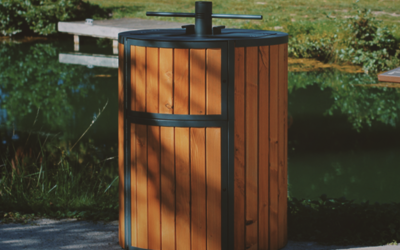Recycling organic waste is an environmentally friendly practice that reduces household waste while producing a rich natural fertiliser for the soil. However, one of the major problems encountered when setting up a bio-waste bin is that it attracts rodents, particularly rats, who find this pile of decomposing matter an ideal environment for feeding and shelter. These pests take advantage of the heat generated by the fermentation of food waste and the presence of organic matter, which encourages them to settle in permanently. An invasion of rats in a waste processing container can cause various problems, ranging from contamination of the compost produced to nuisance for the garden and surrounding homes. Fortunately, there are several effective solutions to prevent these animals from invading the facility and to secure it with a rodent-proof composter designed to limit their access.
Why are rats attracted to organic waste bins and how can you prevent them from settling there?
Rats are omnivorous and opportunistic, which means they feed on all types of organic waste, particularly nutrient-rich food scraps. A poorly maintained fermentation tank containing meat, fish or dairy residues is a prime food source for these rodents, which also find it a safe refuge from predators. The moisture and heat generated by the decomposition of materials create an environment conducive to their development, providing them with ideal shelter throughout the year. To prevent them from appearing, it is essential to adopt good practices by limiting the introduction of substances that may attract rodents and promoting a balance between nitrogenous and carbonaceous materials in order to optimise the process and reduce attractive odours.
How can a rodent-proof composter prevent rats from getting in?
Using a rodent-proof compost bin is one of the most effective ways to prevent these pests from getting in. Designed to stop rodents from getting in, these bins are sealed, often made of sturdy plastic or metal, with a mesh bottom or reinforced base to stop them from getting underneath. The openings of the bin are usually fitted with locking systems that prevent rats from lifting the lid or squeezing inside. Some models are raised, which further limits the possibility of intrusion. The absence of direct contact with the ground reduces the risk of rodents digging to access organic matter, while ensuring good ventilation of the mixture as it decomposes. The use of metal mesh around the device also creates an additional barrier to prevent rodents from getting inside while maintaining the air exchange essential for the fermentation of biowaste.
What simple steps can be taken to limit the attraction of rodents to a compost bin?
Adopting appropriate habits is essential to limit the attraction of rats and ensure effective decomposition of organic matter. The first step is to carefully manage the types of waste added to the container. Animal waste, such as meat, bones, fish or dairy products, should be avoided, as they emit odours that strongly attract rodents. Opt for a mixture of vegetable scraps such as fruit and vegetable peelings, eggshells, coffee grounds and garden waste to reduce the risk of intrusion. It is also important to bury fresh material well under a layer of dry material such as dead leaves or cardboard, which limits the spread of odours and reduces the attraction for rats. Well-balanced fermentation, turned regularly, ensures rapid transformation of biodegradable residues and prevents the formation of stagnant areas that are conducive to rodents settling in.
What natural repellents can keep rats away from a compost bin?
Certain natural repellents can be used to keep rodents away without harming the bio-waste transformation process or the environment. Peppermint, eucalyptus and lavender essential oils are known for their deterrent effect on rats and can be applied around the compost bin to limit their presence. Using repellent plants such as rue, tansy or bay laurel around the compost bin also helps to keep these pests away. Pepper, white vinegar and garlic are other effective natural solutions for disrupting the sense of smell of rodents and preventing them from approaching. Introducing a cat into the garden or placing animal hair around the container can also act as a deterrent by signalling the presence of a potential predator.
Why does the location of the composter influence the presence of rodents?
The location of the rodent-proof composter plays a key role in preventing infestations. It is recommended that you install it at a certain distance from your home to prevent rats from getting too close. A well-lit, open location reduces the risk of intrusion, as rodents prefer dark, unfrequented areas. Placing the bio-waste bin on a concrete slab or fine mesh prevents rats from digging underneath it. It is also advisable to avoid placing it near areas where rodents can easily hide, such as wood piles, dense hedges or stone walls.
Why does a well-maintained compost heap limit the proliferation of rodents?
A well-maintained substrate is essential to prevent pests from settling in permanently. Regular maintenance includes frequent mixing, which prevents comfort zones from forming inside the bin and reduces odours that may attract rats. Checking the moisture content of the substrate is also crucial, as a mixture that is too dry or too wet can encourage pests to settle in. Adding sufficient quantities of dry materials, such as wood shavings or untreated paper, helps to balance the moisture content and make the contents less attractive to rodents. Regularly checking the walls and bottom of the enclosure helps to detect any openings or passages dug by rats, so that they can be quickly repaired and prevent further infestation.
The use of a rodent-proof composter combined with good bio-waste management practices effectively limits the presence of rats and ensures pest-free organic transformation. By choosing a secure model, managing inputs correctly and adopting appropriate preventive measures, it is possible to maintain an effective natural recycling system while respecting the environment.

